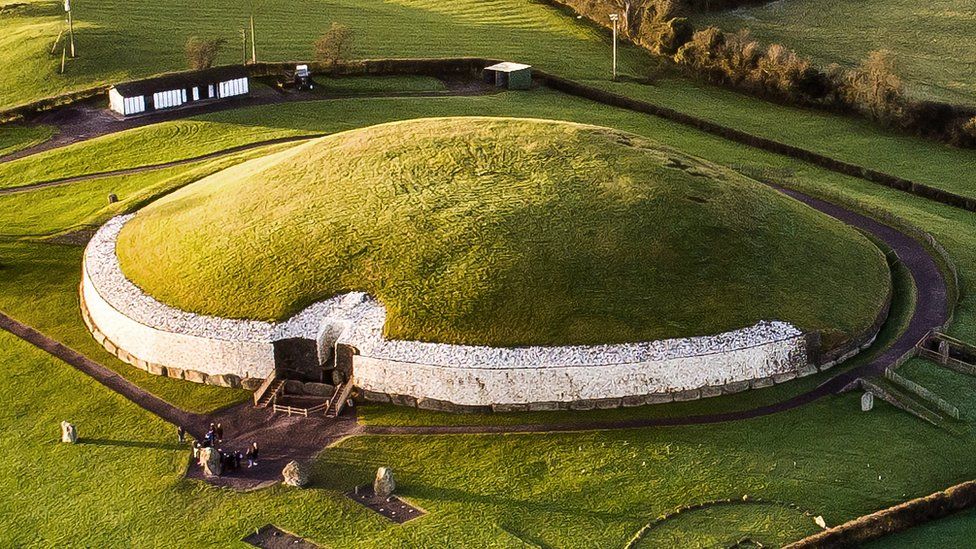According to ancient.eu, Newgrange was built long before Stonehenge, the most famous historical landmark in the United Kingdom. The Neolithic passage tomb in Boyne Valley, County Meath in Ireland, was discovered in 1699 AD and became a tourist attraction. It was then excavated and restored from 1962 to 1975 by the late professor Michael J. O’ Kelly.
What makes it so special? It is known as Irish passage tomb that dates back to 3,200 BC. The large mount is approximately 80m in diameter and surrounded at its base by a kerb of 97 stones. The entrance stone is the most impressive one.
What is it?
According to Ireland’s Ancient East, Newgrance is a 5,200 year old passage tomb located in the Boyne Valley. It was built by Stone Age farmers, with the mount 85m (279ft) in diameter and 13m (43ft) high.
The passage measuring 19m (62ft) leads into a chamber with 3 alcoves. The chamber and the passage are aligned with the rising sun on the mornings around the Winter Solstice.
![]()
The World Heritage Site is surrounded by 97 large stones called kerb stones. Some of them are engraved with megalithic art, with the Entrance stone having the most beautiful and striking design.
The monument in the Boyne Valley is the jewel in the crown of Ireland’s Ancient East. Newgrange is a stand-alone monument, but also part of a complex of monuments built along a bend of the River Boyne, known collectively as Bru na Boinne. The other two principal monuments are Dowth and Knowth.
Every year, almost 200,000 people visit the site. It makes Newgrange the most visited archaeological monument in Ireland. So, if you want to visit it, plan to come early and avoid the crowd.
Myths and Folklore
Similar to Stonehenge, there are always myths and folklore linked with such a monument like Newgrange. Here are some that are plausible and not much plausible.
– According to the Oxford Dictionary of Celtic Mythology, the monument offered hospitality to countless guests in hundreds of stories
![]()
– It provided endless supplies of ale, three trees that were always in fruit, and two pigs, one of which was living
– In some texts, the monument is referred to as the burial place of Lugh Lamhfada (Lugh of the Long Arm), the spiritual father of the great mythical hero Cuchulainn
– In some legends, the place served as the mansion to which Aengus brought the body of Diarmaid after his death on Ben Bulben, so that he could put an aeriel life into him
– Another legend claims Newgrange was the place where the great mythical hero Cuchulainn was conceived by his mother Dechtine
– The romantic tale of Aonghus and Caer, who both flew to Newgrange and lived there in the form of swans, could be linked to the stars. Interestingly, Newgrange is a wintering ground for the Whooper Swan which migrates from Iceland every October and returns in March
With that in mind, here are also some facts about the place.
Built during Stone Age
Newgrange was built during an age in time when the only building materials were stone. Everyday tools and weapons were also made of stone.
![]()
No metal has been found as a primary building material in any Irish passage-grave.
Built for an ancient Irish King
According to ancient Ireland mythology, the Tuatha De Danann ruled Ireland. The story continues saying that they built Newgrange as a burial place for their chief, Dagda Mor, and his three sons.
One of his sons by the name Aonghus, is often referred to as Aonghus of the Brugh. The legend claims he was the owner of the Brugh Land.
How it was built?
Nobody can say how the larger stones, forming the kerb, passage, and chamber of the site were brought to the location.
There are more than 550 large stones that were collected from the ground they’d been lying on above the hills of Newgrange.
![]()
Archeologists believe that the stones were quarried because they were weathered. By that logic, it left ancient people with the huge task of finding the stones that could best be moved, and to invent the means of moving them.
With that in mind, we can be sure that the ancient builders were highly skilled. They grooved the top surface of the passage-roof stones, thus showing they understood redirecting water seepage from the cairn. As a result, it kept the passage waterproof.
The site also has the largest number of carved stones in Ireland. A vast majority of the stones are covered with megalithic art, including the triple spiral that has come to symbolize ancient Ireland itself.



